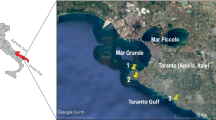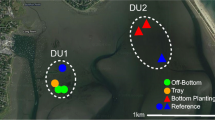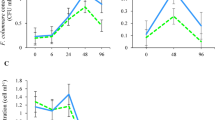Abstract
Marine aggregates were evaluated for their potential role in the ecology of aquatic pathogens using underwater video surveys coupled with direct collection of aggregates in modified settling cones. Six locations, two each in New York, Connecticut, and Massachusetts, were surveyed over 8 months to explore differences in the characteristics of aggregates found in habitats populated by clams (Mercenaria mercenaria) and oysters (Crassostrea virginica). Microaggregate (<500 μm) concentrations were always greater than macroaggregate (>500 μm) concentrations, but peak concentrations of macroaggregates and microaggregates, mean size of particles, and volume fraction of aggregated material varied among the six shallow-water habitats. Concentrations (colony-forming units per ml) of total heterotrophic bacteria (THB) and total mesophilic pathogenic bacteria (MPB) from samples of aggregates were significantly different among the four locations bordering Long Island Sound (LIS). The highest concentrations and enrichment factors in aggregates were observed in August for THB and in June for MPB. Significant correlations were detected for salinity and the concentrations and enrichment factors of THB in aggregates and for the concentrations and percentages of MPB in seawater samples. Significant correlations were also detected for temperature and the concentrations of MPB in aggregates and the enrichment factors for THB and MPB (marginal significance). Bacterial species identified in association with aggregates included: Vibrio cholerea, V. parahaemolyticus, V. vulnificus, V. alginolyticus, Aeromonas hydrophila, Pseudomonas aeruginosa, Escherichia coli, and Mycobacteria sp. These results have important implications for the way in which aquatic pathogens are collected, quantified, and monitored for risk-based surveillance in shallow-water ecosystems.







Similar content being viewed by others
References
Alldredge AL (1979) The chemical composition of macroscopic aggregates in two neritic seas. Limnology and Oceanography 24:855–866
Alldredge AL (2000) Interstitial dissolved organic carbon (DOC) concentrations within sinking marine aggregates and their potential contribution to carbon flux. Limnology and Oceanography 45:1245–1253
Alldredge AL, Silver MW (1988) Characteristics, dynamics and significance of marine snow. Progress in Oceanography 20:41–82
Alldredge AL, Passow U, Logan BE (1993) The abundance and significance of a class of large, transparent organic particles in the ocean. Deep-Sea Research I 40:1131–1140
Audemard C, Reece KS, Burreson EM (2004) Development of real-time PCR for the detection and quantification of the protistan parasite Perkinsus marinus. Applied Environmental Microbiology 70:6611–6618
Brzezinski MA, Alldredge AL, O’Brian LM (1997) Silica cycling within marine snow. Limnology and Oceanography 42:1706–1713
Caron DA, Davis PG, Madin LP, Sieburth JM (1986) Enrichment of microbial populations in macroaggregates (marine snow) from surface waters of the North Atlantic. Journal of Marine Research 44:543–565
Colwell RR, Huq A, Islam MS, Aziz KMA, Yunus M, Huda Khan N, Mahmud A, Sack RB, Nair GB, Chakraborty J, Sack DA, Russek-Cohen E (2003) Reduction of cholera in Bangladeshi villages by simple filtration. Proceedings of the National Academy of Sciences 100:1051–1055
De La Torre C, Vega A, Carracedo A, Toribio J (2001) Identification of Mycobacterium marinum in sea-urchin granulomas. British Journal of Dermatology 145:114–116
Doblin MA, Popels LC, Coyne KJ, Hutchins DA, Cary SC, Dobbs FC (2004) Transport of the harmful bloom alga Aureococcus anophagefferens by oceangoing ships and coastal boats. Applied and Environmental Microbiology 70:6495–6500
Faust MA, Gulledge RA (1996) Associations of microalgae and meiofauna in floating detritus at a mangrove island, Twin Cays, Belize. Journal of Experimental Marine Biology and Ecology 197:159–175
Galluzzi L, Penna A, Bertozzini E, Vila M, Garces E, Magnani M (2004) Development of a real-time PCR assay for rapid detection and quantification of Alexandrium minutum (a dinoflagellate). Applied and Environmental Microbiology 70:1199–1206
Godiwala NT, Vandewalle A, Ward HD, Leav BA (2006) Quantification of in vitro and in vivo Cryptosporidiumn parvum infection by using real-time PCR. Applied and Environmental Microbiology 72:4484–4488
Goedken M, Morsey B, Sunila I, Dungan C, De Guise S (2005) The effects of temperature and salinity on apoptosis of Crassostrea virginica hemocytes and Perkinsus marinus. Journal of Shellfish Research 24:177–183
Grossart PJ, Berman T, Simon M, Pohlmann K (1998) Occurrence and microbial dynamics of macroscopic organic aggregates (lake snow) in Lake Kinneret, Israel, in fall. Aquatic Microbial Ecology 53:105–116
Guy RA, Payment P, Krull UJ, Horgen PA (2003) Real-time PCR for quantification of Giardia and Cryptosporidium in environmental water samples and sewage. Applied and Environmental Microbiology 69:5178–5185
Hara-Kudo Y, Nishina T, Nakagawa H, Konuma H, Hasegawa J, Kumagai S (2001) Improved method for detection of Vibrio parahaemolyticus in seafood. Applied Environmental Microbiology 67:5819–5823
Harvell CD, Kim K, Burkholder JM, Colwell RR, Epstein PR, Grimes DJ, Hofmann EE, Lipp EK, Osterhaus ADME, Overstreet RM, Porter JW, Smith GW, Vasta GR (1999) Emerging marine diseases - Climate links and anthropogenic factors. Science 285:1505–1510
Harvell CD, Mitchell CE, Ward JR, Altizer S, Dobson AP, Ostfeld RS, Samuel MD (2002) Climate warming and disease risks for terrestrial and marine biota. Science 296:2158–2162
Huq A, Sack RB, Nizam A, Longini IM, Nair GB, Ali A, Morris JG, Khan MNH, Siddique AK, Yunus M, Albert MJ, Sack DA, Colwell RR (2005) Critical factors influencing the occurrence of Vibrio cholerae in the environment of Bangladesh. Applied and Environmental Microbiology 71:4645–4654
Jackson R, Maffione D, Costello K, Alldredge AL, Logan BE, Dam HG (1997) Particle size spectra between 1 μm and 1 cm at Monterey Bay determined using multiple instruments. Deep-Sea Research 44:1739–1767
Kach D, Ward JE (in review) The role of marine aggregates in the ingestion of pico-particles by suspension-feeding molluscs. Marine Biology
Kiørboe T (2001) Formation and fate of marine snow: small-scale processes with large-scale implications. Scientia marina 65:57–71
Kiørboe T, Tiselius P, Mitchell-Innes B, Hansen JLS, Visser AW, Mari X (1998) Intensive aggregate formation with low vertical flux during an upwelling-induced diatom bloom. Limnology and Oceanography 43:104–116
Kiørboe T, Grossart HP, Ploug H, Tang K, Auer B (2004) Particle-associated flagellates: swimming patterns, colonization rates, and grazing on attached bacteria. Aquatic Microbial Ecology 35:141–152
Louis VR, Russek-Cohen E, Choopun N, Rivera ING, Gangle B, Jiang SC, Rubin A, Patz JA, Huq A, Colwell RR (2003) Predictability of Vibrio cholerae in Chesapeake Bay. Applied and Environmental Microbiology 69:2772–2785
Lyons MM, Ward JE, Smolowitz R, Uhlinger KR, Gast RJ (2005) Lethal marine snow: Pathogen of bivalve mollusc concealed in marine aggregates. Limnology and Oceanography 50:1983–1988
Lyons MM, Smolowitz R, Dungan CF, Roberts SB (2006) Development of a real time quantitative PCR assay for the hard clam pathogen Quahog Parasite Unknown (QPX). Diseases of Aquatic Organisms 72:45–52
Mari X, Burd A (1998) Seasonal size spectra of transparent exopolymer particle (TEP) in a coastal sea and comparison with those predicted using coagulation theory. Marine Ecology Progress Series 163:63–76
Myers ML, Panicker G, Bej AK (2003) PCR detection of a newly emerged pandemic Vibrio parahaemolyticus O3:K6 pathogen in pure cultures and seeded waters from the Gulf of Mexico. Applied and Environmental Microbiology 69:2194–2200
Newell CR, Pilskaln CH, Robinson SM, MacDonald BA (2005) The contribution of marine snow to the particle food supply of the benthic suspension feeder, Mytilus edulis. Journal of Experimental Marine Biology and Ecology 321:109–124
Panicker G, Myers ML, Bej AK (2004) Rapid detection of Vibrio vulnificus in shellfish and Gulf of Mexico water by real-time PCR. Applied and Environmental Microbiology 70:498–507
Passow U, Alldredge AL (1994) Distribution, size and bacterial colonization of transparent exopolymer particles (TEP) in the ocean. Marine Ecology Progress Series 113:185–198
Pilskaln CH, Lehmann C, Paduan JB, Silver MW (1998) Spatial and temporal dynamics in marine aggregate abundance, sinking rate and flux: Monterey Bay, central California. Deep-Sea Research II 45:1803–1837
Ragone-Calvo LM, Walker JG, Burreson EM (1998) Prevalence and distribution of QPX, Quahog Parasite Unknown, in hard clams Mercenaria mercenaria in Virginia, USA. Diseases of Aquatic Organisms 33:209–219
Riebesell U (1991) Particle aggregation during a diatom bloom I: Physical aspects. Marine Ecology Progress Series 69:273–280
Riisgård HU (1988) Efficiency of particle retention and filtration rate in 6 species of Northeast American bivalves. Marine Ecology Progress Series 45:217–223
Riley GA (1963) Organic aggregates in seawater and the dynamics of their formation and utilization. Limnology and Oceanography 8:372–381
Shanks AL (2002) The abundance, vertical flux, and still-water and apparent sinking rates of marine snow in a shallow coastal water column. Continental Shelf Research 22:2045–2064
Simon M, Grossart H, Schweitzer B, Ploug H (2002) Microbial ecology of organic aggregates in aquatic ecosystems. Aquatic Microbial Ecology 26:175–211
Turner JT (2002) Zooplankton fecal pellets, marine snow, and sinking phytoplankton blooms. Aquatic Microbial Ecology 27:57–102
Venkateswaran K, Kiiyukia C, Nakano H, Matsuda O, Hashimoto H (1990) The role of sinking particles in the over wintering process of Vibrio parahaemolyticus in the marine environment. FEMS Microbial Ecology 73:159–166
Ward JR, Lafferty K (2004) The elusive baseline of marine diseases: are marine diseases in ocean ecosystems increasing? PloS Biology 2(4):E120
Wolanski E, Richmond R, McCook L, Sweatman H (2003) Mud, marine snow and coral reefs. American Scientist 91:44–51
Acknowledgments
The authors thank C. Romano, R. Bogin, M. Perrigault, and S. Dahl for laboratory assistance with processing samples and T. Marcotti, K. Uhlinger, B. Holohan, D. Kach, D. Frank, J. Thiel, and P. Bagnell for assistance with field collections. They also thank B. MacDonald and A. Bennett for recommendations on image processing and T. Getchis for assistance with outreach. This research was funded by NSF-NIH Ecology of Infectious Disease Grants to JEW (0429004), RS and JV (0429018), and BA (0429051) along with a NOAA grant to BA (R/FBF-17 award NA16RG1645) and an NRAC grant to RS.
Author information
Authors and Affiliations
Corresponding author
Rights and permissions
About this article
Cite this article
Lyons, M.M., Lau, YT., Carden, W.E. et al. Characteristics of Marine Aggregates in Shallow-water Ecosystems: Implications for Disease Ecology. EcoHealth 4, 406–420 (2007). https://doi.org/10.1007/s10393-007-0134-0
Received:
Accepted:
Published:
Issue Date:
DOI: https://doi.org/10.1007/s10393-007-0134-0




